Besides the demand-side pressures, the challenges have been further accentuated by consistently firm cotton fibre prices resulting in subdued contribution margins, as well as strengthening of the Indian currency vis-a-vis currencies of the competing nations, thereby affecting realisations. As a result, Q1 FY2018 was the weakest first quarter for the domestic spinners during the past six years in terms of profitability. Nevertheless, the debt coverage metrics continue to improve on a YoY basis, given the secular decline in term debt level and decline in borrowing costs.
Improved supply of cotton fibre is, however, expected to provide some respite to the domestic spinners during H2 FY2018. There has been a ~12% increase in sown area in Cotton Year (CY) 2018, driven by firm cotton prices, which made it remunerative for the farmers to choose cotton against competing crops. Although the weather conditions have been largely favourable, erratic monsoonrainfall in Southern and Central India, flooding in some regions of North Gujarat (the largest cotton producing state of the country) and pest problems in some areas may impact average yield for the season. Accordingly, the yields are expected to be lower vis-a-vis the yield of 531 kg/ hectare reported in the previous cotton season. Even with a yield of ~505 kg/ hectare, at a level close to the past 3-year average, the cotton crop output is expected to grow by ~5% to ~36 million bales in CY2018.
Says Jayanta Roy, Senior Vice-President and Group Head, Corporate Sector Ratings, ICRA, “The level of global cotton production in CY2018 is estimated to exceed consumption, after two consecutive years of shortfall. The resultant cotton surplus therefore will create a downward bias in prices which, besides easing pressure on contribution margins of the spinners, is likely to bring down their working capital requirements. This augurs well for the domestic cotton spinning industry.”
Spinners’ contribution levels have remained under continued pressure averaging at ~Rs. 75/ kg in the past 15 months, ~7% lower than the average for the 4-year period prior to that. The exception to this was in July and August 2016 when the same declined sharply owing to a lag in price adjustments following a spurt in cotton prices; and in September 2017 when yarn prices declined. While the cotton-yarn prices were holding firm till August 2017 despite demand-side pressures, the same have corrected by ~5% in September 2017 in light of sustained demand-side pressures as well as in anticipation of softening of cotton prices. This has resulted in a contraction in contribution margins of the spinners during the month, as cotton prices did not correct correspondingly.
“Decline in yarn realisations has preceded a decline in cotton-fibre prices, which has affected contribution margins of spinners in recent weeks and is likely to reflect in second-quarter performance of the spinners. However, with further correction in cotton prices expected with the commencement of harvest season in October 2017 onwards, ICRA expects the spinners’ profitability to improve during the second half of the current financial year,” Roy added.
Cotton stocks in China continue to be higher than historical averages. As per the estimates, it will take about two to three more years for excess stocks to reach historical average levels, and therefore for imports by China to revive. Nevertheless, with conclusion of this year’s cotton auctions, a recovery in yarn demand from China is likely to help the Indian yarn exporters in the second half of FY2018. Further, Indian yarn exporters are trying to diversify export markets to increase their sales volumes.


